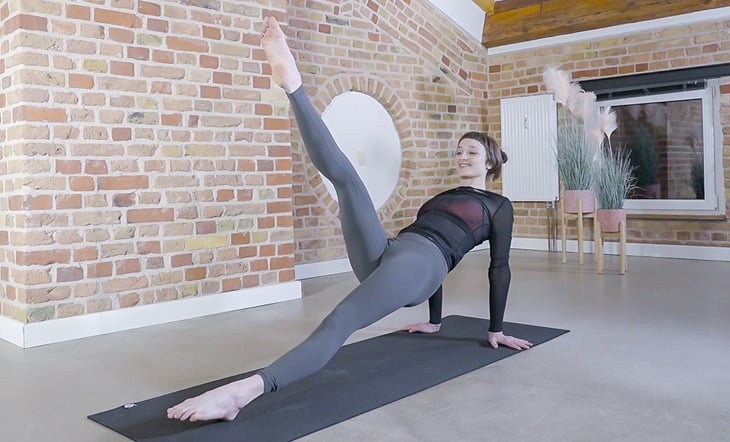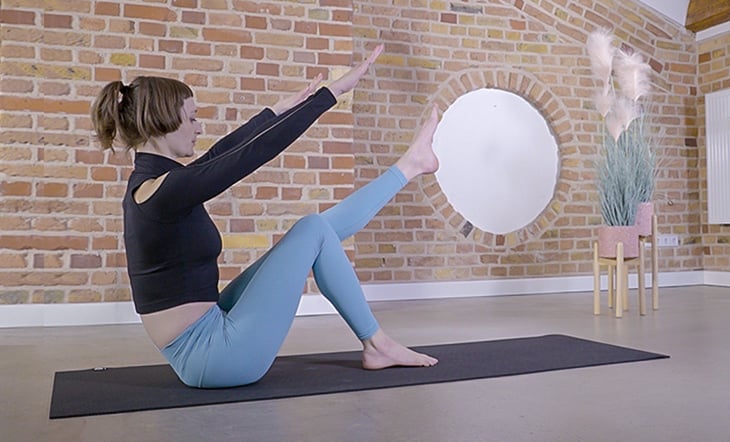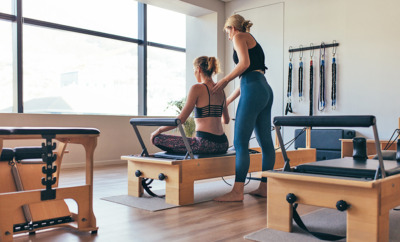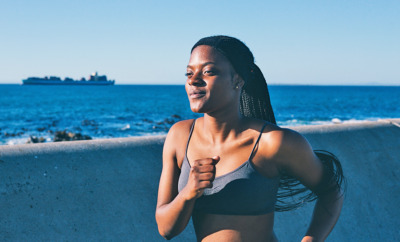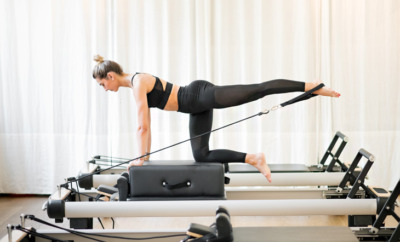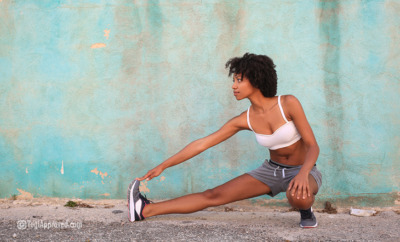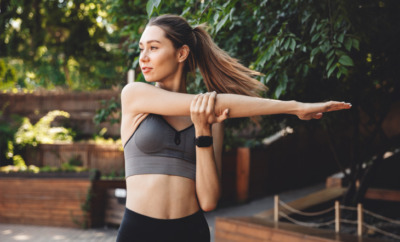What Exactly Is Wall Pilates? Plus 5 Wall Pilates Exercises to Try at Home
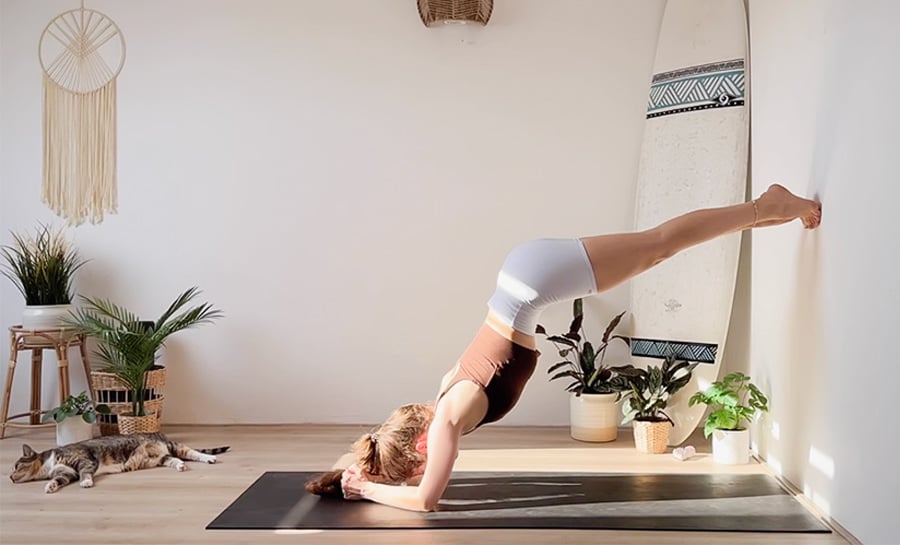
Wall Pilates might just be the full-body exercise that you’ve been looking for. Pilates wall workouts share many characteristics with general Pilates, but add unique movements that work your muscles in different ways. Plus wall Pilates bring an impressive array of benefits (read on to learn more).
If you’re wondering, “what is wall Pilates?” then dive in. This article is your complete guide to wall Pilates exercises, benefits and everything you need to know to start (or deepen) this popular exercise format.
What Is Wall Pilates? How Does It Compare to the Mat or Reformer?
Before defining wall Pilates, it helps to know what Pilates is. Joseph Pilates founded this exercise form to assist dancers in recovering from frequent repetitive motion injuries.
What Is Pilates? Here’s Your Introductory Guide to the Practice
The original Pilates program uses either a mat or a specialized machine called a reformer to perform various exercises intended to tone muscle, build strength and improve your range of motion.
Wall Pilates takes many of the same moves used in mat or reformer-style Pilates and substitutes a wall as a prop. You’ll perform many of the same exercises, such as glute bridges and crunches, but you’ll change the assistive tool you use.
Take This Beginner Wall Pilates Class
Main Benefits of Wall Pilates Exercises
Pilates wall workouts over multiple benefits. Check out everything you can achieve with a regular practice.
1. Improved Strength and Muscle Tone
The unique combination of strength, toning and resistance drills used in wall Pilates exercises provide a moderate cardiovascular workout while incorporating nearly every muscle group.
Using the wall increases the intensity of certain moves without weights or other equipment, making it accessible to everyone. While even resistance bands are out of some budgets, anyone can find a wall.
Strength training becomes more vital as you age. Sarcopenia is a fancy term that refers to the loss of muscular strength that occurs over time. A recent review of multiple studies spanning 40 years confirms that performing resistance training through all life stages combats this tendency while reducing injury and even Type 2 diabetes risk.
2. Increased Flexibility and Range of Motion
As your muscles contract with exercise or simple daily use, the fibers become shorter and less pliable. Stretching keeps these fibers lengthened and flexible, decreasing your injury risk. Think of unstretched muscles as rubber bands left in a freezer. One good tug is all it takes to snap them. However, when warmed to room temperature, they become more difficult to break.
Flexibility works in tandem with strength training to help you age gracefully. While some moves strengthen the muscles around your hips, quads and hamstrings, they also tighten these muscles, causing alterations in other groups.
For example, many people with tight hamstrings develop lower back pain. Stretching seems to counteract this effect, letting you maximize the benefits of your resistance work.
Wall Pilates combines strength and flexibility in one workout, giving you the best of both worlds. Talk about a win-win!
3. Serious Core Strength
Your core is your body’s center of gravity. It protects your internal organs while holding you upright so you can make use of those handy opposable thumbs. Building core strength also decreases your injury risk as it helps you maintain your balance, preventing falls.
Among the many benefits of abdominal strength, here are a few that are particularly important:
- Protects your spine
- Strengthens your spine
- Improve your athletic performance
- Makes all exercises more safe and effective
- Improve your posture
10 Mat Pilates Exercises to Build Serious Core Strength
4. Stress Less
Stress is a modern American epidemic, contributing toward ever-rising rates of chronic disease. What happens in your mind affects your body and vice-versa — you cannot separate the two.
The best part of exercise is that it works on the physiological results of stress, like excess cortisol. Lower-intensity exercise that keeps you under 40% of your VO2 max lowers cortisol levels, easing overwhelming sensations even when the external stressors remain.
What is VO2 max? It is your oxygen uptake, meaning your VO2 max illustrates how much oxygen your body absorbs and expends during physical exertion.
5. Fewer Headaches and Less Chronic Pain
Chronic pain takes a significant toll on your quality of life. The good news about wall Pilates is that you might find your headaches and body aches decreasing with a regular practice.
The effect works in multiple ways. Sometimes, various moves might ease adhesions in the fascia, which relieves pain as this connective tissue has more nerves than muscles. Body awareness also helps identify any pain triggers (more on that in the next point).
What Is Fascia? Our Fascial Specialist Shares the Important Things to Know
Stress relief provides the other part of the puzzle, decreasing inflammatory chemicals and increasing those that elevate your overall sense of well-being.
6. Greater Body Awareness
Although wall Pilates doesn’t emphasize mindfulness the way yoga does, you can still gain a keener understanding and appreciation of the mind-body connection through your practice.
Pilates provides a moderately intense workout – just enough to make you mindful of how different postures affect how other body parts feel. You might even notice mood changes.
Tune in, perhaps performing a body scan during longer isometric holds to get better acquainted with your physical self. When you learn what feels good and what doesn’t, remedying minor aches and pains through movement becomes easier.
Try These 5 Wall Pilates Exercises at Home Today
You want to get started, but you aren’t sure you’re up for an hour-long wall Pilates workout yet. That’s okay! You can practice the following five Pilates wall exercise moves in the privacy of your home to get a good sense of this exercise format.
Another perk? You can take these moves on the road. Every hotel room has four walls, and they don’t line every square inch with furniture. Isn’t it great knowing you can maintain your fitness anywhere? Here’s what to add to your exercise arsenal.
1. Roll Downs
Here’s a perfect warm-up and cool-down wall Pilates move that focuses on full-body flexibility. It also gently elevates your heart rate to ease you into your exercise section.

@wildwives.yoga
Begin by standing with your back flat against the wall from the top of your head to your tailbone. Extend your feet about six to ten inches in front of you (depending on your height and body configuration).
Raise your hands overhead so that the backs of your hands touch the wall, elongating your spine. Then, begin peeling away as you roll down one vertebrae at a time. Imagine your spine is made of velcro, and you’re peeling it off all the way down until you touch your toes.
As you build strength, add variety to this wall Pilates move by adding a walk-out inchworm. As your fingers reach the floor, begin walking forward until you achieve a plank position. From there, step one foot up next to the front palm for a lunge stretch. Repeat on the opposite side. Return to plank and walk yourself back to standing, feeling your core contract as you lift back to standing.
Read: 4 Common Mistakes In Plank Pose + How to Fix Them
2. Wall Squats With Arm Raises
This move incorporates the big muscles of your legs, firing up the cardiovascular portion of your wall Pilates workout. It also warms up your upper body.

@wildwaves.yoga
Begin by standing with your back flat against the wall. Slowly bend your knees as you walk your toes forward until you create a rectangle beneath you. Your knees should be bent at roughly 90° angles (it’s okay to go higher if you need time to build up your strength). Hold this position as an isometric contraction.
Once you achieve the leg position, place your arms by your sides with your palms touching the wall. Keeping your arms straight, raise your hands above your head so that your nails touch the wall, then lower back down — all while holding the stationary squat with your legs.
You can add nearly infinite variety with your arm movements. Doing so helps distract you from the work your legs are doing. Raise them laterally as if making a snow angel or extend to shoulder height, bending your arms in toward your chest and unfurling them as you expand.
3. Marching Glute Bridges
Here’s another move that fires up your legs and works deep into your glute muscles. You’ll begin this move with a standard wall bridge, which is an exercise in itself.

@wildwaves.yoga
Start lying on your back with your tush about ten inches from the wall. Your knees and hips should both bend at slightly more than 90 degrees. Press the bottom of your feet into the wall and lift your hips to come into a glute bridge. You’ll notice your range of motion isn’t as great as it is when you use the floor for resistance — that’s normal.
While holding this contraction, march one foot away from the wall, then the other. The effect should be as if you are marching in place on the wall. Perform several repetitions, maintaining the isometric contraction in the hips, before resting and trying again.
5 Beginner-Friendly Yoga Poses to Strengthen and Tone Your Booty
4. Wall Push-Ups
It’s time to work your upper body. Wall push-ups work your triceps, biceps and chest muscles and even bring your shoulders into the mix.

@wildwaves.yoga
Begin by standing a foot or more away from the wall. Place your hands so that they’re roughly even with the midline of your chest. Lean your body weight forward as if the wall were the floor, and you were going to perform a traditional pushup.
You can use variety here, too. Want to test your balance? Try a one-armed wall pushup. When you master that move, add a leg lift with the opposite leg. You can really feel your upper body work now.
Play with hand positioning, too. Placing them wider with your elbows out puts more emphasis on your chest and shoulders, while bringing them in and keeping your elbows narrow hits your triceps more.
5. Wall 100s
The 100s are perhaps the most well-known Pilates core exercises. You can do several wall variations as you build strength.

@wildwaves.yoga
The easiest method is to begin lying on your back, creating the same rectangle beneath your knees as you did for the wall squats. Both knees and hips should bend at roughly 90° angles. Curl your head, shoulders and upper back off the floor as you contract your abdominal muscles. Extend your fingertips toward your feet and make small pressing movements downward as you take quick breaths.
To add variety to this move, adjust your feet. You can widen the angle of your knees. You can also throw in a combo move, performing one wall glute bridge followed by a set of 100s.
Practice These 6 Bodyweight Exercises for a Full-Body Workout at Home
Tips to Maximize Your Pilates Wall Workouts
You’ve mastered these five moves and maybe watched a TikTok or YouTube video or two. You’re ready to take your first class! Here are a few tips to help.
First, use your network. Do you know anyone else who is into Pilates? Getting over your initial class jitters is easier if you bring a friend or find an accountability partner to keep each other motivated.
Remember to keep an open mind, since some of the wall Pilates exercises will be unfamiliar or challenging at first. Having an open mind will keep you positive and boost your confidence. It will also help keep you safe, since you’re focused on learning each move.
If you’re able to, it’s always good to talk to your instructor before or after class. Ask them about their teaching style, the intensity level you can expect and any tips they have for success. If any specific questions come up during class, you can ask afterward. If you practice online, you can ask in the comments or reach out directly.
Where Can I Find Wall Pilates Classes?
Wall Pilates is one of today’s hottest TikTok trends and Instagram fitness trends so those platforms are always a good place to find inspiration.
You can ensure you follow a licensed instructor by signing up for a class at the gym, a Pilates studio, or with an online platform like YA Classes. Depending on how your fitness center runs, you might simply drop into a session and give it a whirl.
Starting and Sticking With a Wall Pilates Practice
Beginning your wall Pilates practice is easy — sticking with it is the tough part. If you’ve followed this guide, you have all the tools you need to start your training and find the right class to keep you going with variety and camaraderie as you grow together.
Keep an upbeat attitude. Remember, every form of exercise is a practice — there’s no such thing as perfection –– only endless, beautiful variations.
Be patient with yourself and listen to your body. When you feel unmotivated or unable to stick to your routine, take baby steps and hold yourself accountable to that minimum. For example, try doing five minutes of Pilates wall exercises. If it’s too hard to continue after, allow yourself to stop (but you might find you can push through after that initial mindset hurdle).
How long it takes to acquire a new habit and fully integrate it into your life varies from person to person. However, the beauty part of wall Pilates exercises is that you can do them anytime, anywhere, in the available time you have.
Be patient but persistent, and before long, you’ll enjoy a healthier body, an improved sense of well-being and a positive new pastime in wall Pilates to share with those you love.
Looking for More Pilates Classes?
Try one of these classes today.


This Month's Letter
From the Editor
Monthly motivation and food for
thought from our founder.




